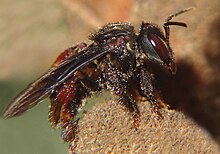Nymphaea pulchella
 From Wikipedia the free encyclopedia
From Wikipedia the free encyclopedia
| Nymphaea pulchella | |
|---|---|
| Scientific classification | |
| Kingdom: | Plantae |
| Clade: | Tracheophytes |
| Clade: | Angiosperms |
| Order: | Nymphaeales |
| Family: | Nymphaeaceae |
| Genus: | Nymphaea |
| Species: | N. pulchella |
| Binomial name | |
| Nymphaea pulchella | |
| Synonyms[1] | |
| |
Nymphaea pulchella is a species of waterlily native to the regions spanning from Central and Southern Mexico to Brazil, as well as from the Bahamas to the Virgin Islands, including St. Croix.[1]
Description[edit]
Vegetative characteristics[edit]
Nymphaea pulchella is an aquatic herb[2] with cylindrical to subglobose tubers.[3] The elliptic, suborbicular to orbicular leaves have a sinuate to dentate margin.[4] The veins show minimal prominence on the abaxial leaf surface.[5]
Generative characteristics[edit]
The diurnal flowers can extend up to 20 cm above the water surface.[4] They are held up by glabrous, brownish, non-brittle peduncles with six primary central and 12-13 secondary peripheral air canals.[3] The androecium consists of 43-80 stamens.[3] The ellipsoid, smooth, hispid seeds have trichomes arranged in continuous longitudinal lines.[4]
Reproduction[edit]
Vegetative reproduction[edit]
Proliferating pseudanthia are absent.[3][4]
Generative reproduction[edit]
It is autogamous, but reproduction is more fruitful in the presence of pollinators.[6] Flowering and fruiting occurs throughout the year. Generative reproduction is the main mode of reproduction.[3]
Taxonomy[edit]
Publication[edit]
It was first described by Augustin Pyramus de Candolle in 1821.[1][5]
Placement within Nymphaea[edit]
It is placed in Nymphaea subgenus Brachyceras.[7][6]
Etymology[edit]
The specific epithet pulchella means "beautiful" or "pretty".[8][9]
Conservation[edit]
In Puerto Rico, USA, it faces habitat destruction.[10]
Ecology[edit]

Habitat[edit]
It occurs in freshwater habitats, such as lakes, ponds,[11] lagoons,[10] streams, and temporary puddles.[2]
Pollination[edit]
The bee species Trigona spinipes is an effective pollinator of Nymphaea pulchella. In some cases, the bees coated in pollen fall into the stigmatic fluid and die.[6][3] The flowers are also visited by the bee species Apis mellifera, as well as flies.[3]
Herbivory[edit]
The bee species Trigona spinipes is florivorous, i.e. it consumes parts of the flowers of Nymphaea pulchella.[6]
References[edit]
- ^ a b c d "Nymphaea pulchella DC". Plants of the World Online. Royal Botanic Gardens, Kew. Retrieved 19 July 2023.
- ^ a b Felix, C. D. M. P. (2019). "Etnobotânica, florística, e citogenética na Serra do Jatobá, no Cariri da Paraíba, nordeste do Brasil."
- ^ a b c d e f g de Lima, C. T., Machado, I. C., & Giulietti, A. M. (2021). "Nymphaeaceae of Brasil." Sitientibus série Ciências Biológicas, 21.
- ^ a b c d Pellegrini, M. O. O. & Jardim Botânico do Rio de Janeiro. (n.d.-b). Nymphaea pulchella DC. Flora E Funga Do Brasil. Retrieved December 29, 2023, from https://floradobrasil.jbrj.gov.br/FB19912
- ^ a b "Regni vegetabilis systema naturale, sive ordines, genera et species plantarum secundum methodi naturalis normas digestarum et descriptarum." p. 51. (1821). Vereinigtes Königreich: (n.p.).
- ^ a b c d e Chalegre, S. L., Domingos-Melo, A., de Lima, C. T., Giulietti, A. M., & Machado, I. C. (2020). Nymphaea pulchella (Nymphaeaceae) and Trigona spinipes (Apidae) interaction: From florivory to effective pollination in ponds surrounded by pasture. Aquatic Botany, 166, 103267.
- ^ Marquina, S., Bonilla-Barbosa, J., & Alvarez, L. (2005). "Comparative phytochemical analysis of four Mexican Nymphaea species." Phytochemistry, 66(8), 921-927.
- ^ Dictionary of Botanical Epithets. (n.d.). Retrieved December 29, 2023, from http://botanicalepithets.net/dictionary/dictionary.150.html
- ^ What do those botanical names mean - Rainyside.com. (n.d.). Retrieved December 29, 2023, from https://www.rainyside.com/resources/reference/latin.html
- ^ a b Woodbury, R. O. (1975). "Rare and Endangered Plants of Puerto Rico: A Committee Report." p. 61. USA: U.S. Department of Agriculture, Soil Conservation Service.
- ^ Liogier, A. H., Martorell, L. F. (2000). "Flora of Puerto Rico and adjacent islands : a systematic synopsis." p. 58. Puerto Rico: Ed. de la Universidad.